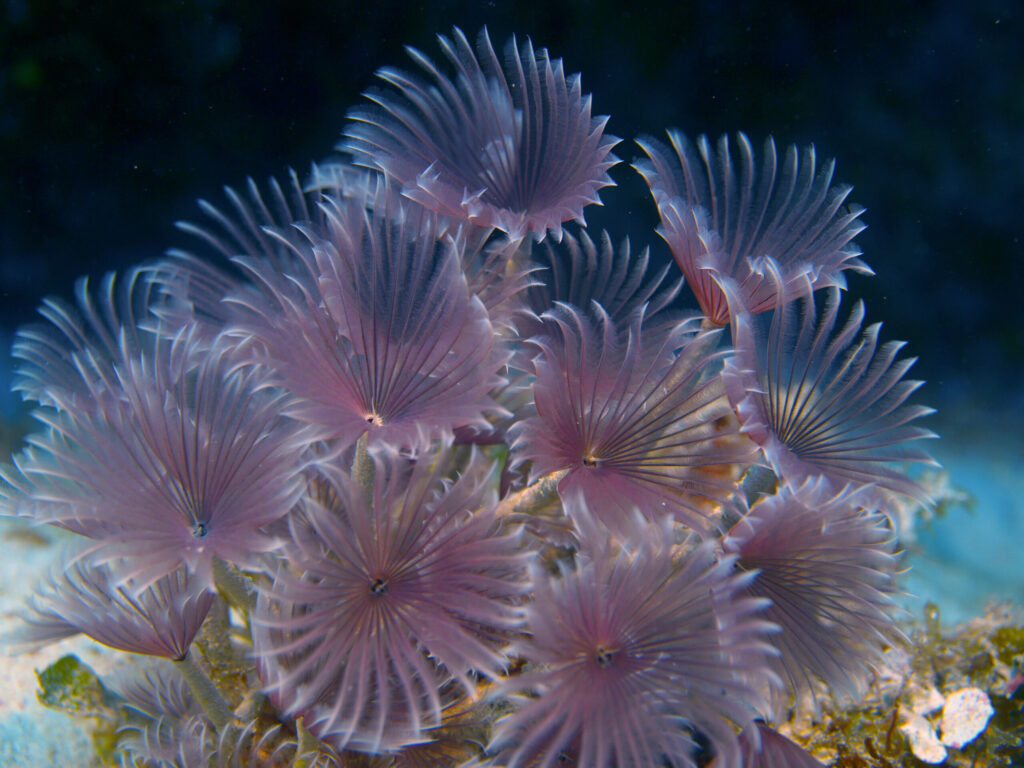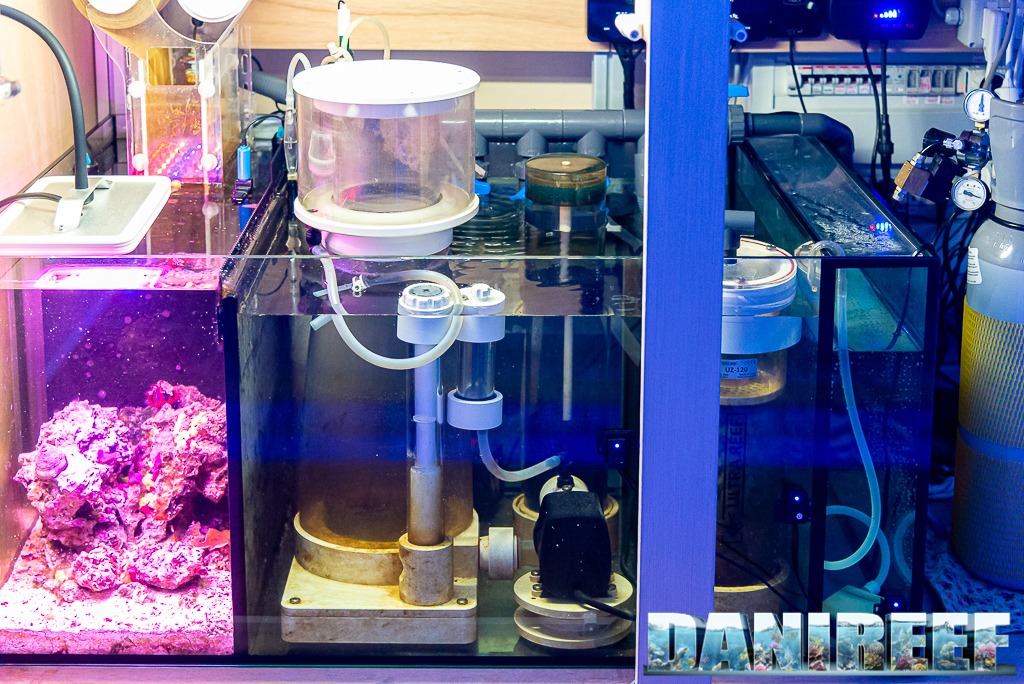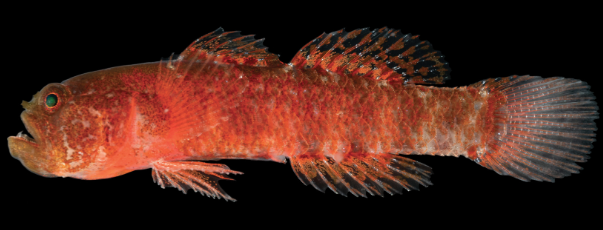The Feather Duster Worm won’t be cleaning your tank but it will be improving its appearance and contribute to the overall ecosystem as a natural filter feeder. These delicate guys are low maintenance and can share the space with many reef safe fish.
Just make sure to stay away from a few predators that could easily make your worm a snack. In this guide you’ll learn everything you need to keep your Feather Duster Worm healthy from feeding, to diseases and prevention.
Don’t forget to check the sections on your worm coming out of the tube and confusing it with sea anemones. Let’s dive in!
Quick Facts
| Scientific Name: | Sabellidae sp |
| Other Names / Common Species: | Fan Worm, Hawaiian, Dwarf, Royal, Yellow, Coco Feather duster worm |
| Lifespan: | 1-2 years |
| Size: | 3-6in diameter |
| Care: | Easy but vulnerable to copper |
| Diet: | Zooplankton/phytoplankton, rotifer cultures, and water algae |
| Water Parameters: | 72-83F, 8.1-8.2pH, 8-12dKH, 1.024-1.026SG |
| Tank Size: | 10+ gallons |
| Behavior: | Docile and passive |
| Breeding Difficulty: | Low – broadcast spawners. |
Species Summary
Believe it or not, it is a distant cousin of the common earthworm that’s often spotted along terrestrial gardens and walkways, the Feather Duster Worm (Sabellidae sp.) is known as a sea-dwelling member of the annelid phylum – that includes all those segmented worms we know and love like leeches and bristle worms, etc.
This tiny saltwater worm even has the same segmented anatomy as its land-loving cousin once you get a closer look!
However, most people are too distracted by the feathery, mane-like crown that gives this ornate worm its name to notice little details. Aside from being quite beautiful and distinctive, this gill-like crown actually helps the Feather Duster Worm to draw plankton and bacteria toward its mouth. The Feather Duster Worm is sometimes called the Fan Worm.
Author Note: The Feather Duster Worm is generally considered a peaceful tank citizen. As filter feeders, Feather Duster Worms will spend the majority of their time hidden within their tubular bodies while waiting for food particles to drift toward them.
When will my duster worm come out?
When feeling stressed or attacked. That’s when your worm might get a little more active, trying to find a safer spot. We’ll talk about that more in just a bit!
Appearance and Types
A Feather Duster Worm resembles a living feather duster! The bodies of these worms consist of feather-like tentacles called radioles. Coloration can be pink, purple, yellow, tan, or golden and even white.
Don’t count on making eye contact with your new Feather Duster Worm! These eyeless, faceless worms rely exclusively on their sensory skills to respond to light and motion, and water movement to navigate their environment.. In fact, you’ll see a worm’s tentacles retract instinctively whenever an object comes near its body.
There are two core varieties of Feather Duster Worms found in aquariums.
- Sabellid Feather Duster Worm. Sabellids use mud, sand, debris, and glue-like mucus secretions to build tubes. As natural engineers, these crafty worms can actually construct new tube “homes” in a matter of hours!
- Serpulid Feather Duster Worm. Serpulids have a talent for building hard, chalky tubes. They prefer coral, live rock, and other hard surfaces when making homes. It can be quite fascinating to watch them secure their bodies to hard surfaces by secreting sticky, glue-like acid.
Lifespan
A typical Feather Duster Worm will have a lifespan of 1 to 2 years. Like all aquarium creatures, Feather Duster Worms require quality water conditions to thrive.
Your feathery friend may give you a clue that all is not right in the tank by shedding its radioles. Consider this a warning sign that you need to stabilize tank conditions.
My worm has lost its crown, what do I do?
Don’t panic. Feather Duster Worms will regenerate new radioles within a few weeks as long as they have healthy living conditions.
Average Size
While the Feather Duster Worm’s crown gives this critter a larger-than-life appearance, this will be a very tiny addition to your tank. The average diameter size of a Feather Duster Worm is 3 to 6 inches. Most grow to be 2 inches to 2.5 inches in length.
There is a type of worm called the Giant Feather Duster that can grow up to 8 inches in diameter.
Feather Duster Worm Care
Feather Duster Worms aren’t especially choosy when it comes to tank conditions. However, they are vulnerable to copper in the same way that most reef invertebrates are.
Water Parameters
- Water temperature: 72 to 83°F
- pH levels: 8.1 to 8.2
- Water hardness: 8 to 12 dKH
- Specific gravity: 1.024 to 1.026
Feather Duster Worms crave pristine water conditions with near-zero levels of ammonia, nitrite, and nitrates. Leftover food particles can pollute the water so regular maintenance and a protein skimmer or refugium are strongly recommended. Including other filter feeders like sponges, corals, and crinoids in your aquarium can help maintain excellent water quality.
Should I test my water for Copper?
Yes! Copper testing your water source is advised before you welcome one of these frilly, feathery worms.
It’s also generally recommended that you introduce a Feather Duster Worm to a mature tank that has been running for between six and 12 months to ensure that your little worm will have plenty of microorganisms to feast on!
Tank Setup
There’s no need to worry about placing Feather Duster Worms under any kind of specialized lighting. They generally like gentle water flow with plenty of live rock.
Do your best to keep these worms away from strong water flow that could disrupt their feeding habits.
Tank Size
There are no strict tank guidelines for Feather Duster Worms. These aquatic wigglers can thrive as long as they have enough space for spreading out their radioles to capture food.
Just keep in mind that ravenous worms may eat up microorganisms quickly in a smaller tank. Generally, experts recommend keeping Feather Duster Worms in medium or large tanks that exceed 10 gallons in size to ensure that this species will have enough feeding opportunities. If you want to stay within that size check our 4 best 10-gallon tanks.
Tank Placement
Feather Duster Worms live their best lives in substrate composed of sand or crushed coral. Your worm will attach to the substrate after becoming acclimated.
Author Note: One helpful tip to know is that you should avoid touching a Feather Duster Worm when cleaning a tank due to the delicate and fragile nature of this creature’s tube.

Feather Duster Worm Coming Out of Tube
There may come a time when you discover that your Feather Duster Worm is out of its tube. This can be concerning, as these beautiful creatures generally only leave their tubes under specific circumstances. Generally, a Feather Duster Worm has evacuated its tube because of poor water conditions (temperature, salinity, pH, etc.). Common reasons why you might find a worm out of its tube include:
- High ammonia or nitrate levels in the water.
- Stress caused by changing water conditions.
- Changes in light exposure.
- Disruptions from other sea creatures.
- Lack of food.
Author Note: Feather Duster Worms evacuate their tubes as part of a defense mechanism. Evaluate the situation by testing water conditions, looking for predatory behaviors from tank mates, and assessing food levels. While you may be adding food to the tank regularly, you could be underestimating how much food is actually needed if there are many creatures in the aquarium.
When your Feather Duster Worm has abandoned its tube, try the following two options.
- Try to coax the worm back in its tube using a soft brush. To do this, patiently guide the worm back into its tube using a gentle touch at the base of its body.
- Provide the worm with a new tube if you’re unable to lure it back into its native tube. The best way to do this is to attach a new tube to the side of the tank. You can also simply glide a tube next to the worm to see if it moves in on its own.
Important: Remember, a feather duster worm losing its crown is unfortunately a sign it might not survive. But if the crown is intact, there’s always hope for recovery!
Common Possible Diseases & Prevention
The truth is that little is known about the diseases affecting invertebrates. The good news is that Feather Duster Worms are known to be pretty resilient to illness.
One thing that is certain is that Feather Duster Worms can become ill when fish treatments and drugs containing copper are added to a tank. If you’re treating other residents of a tank, it’s highly advised that you use a quarantine system to keep the water untainted!
Author Note: Physical injuries can make worms vulnerable to other health problems. Choose tank mates carefully and handle worms gently.
Signs of a healthy feather duster:
- Vibrant Coloration: The worm’s feathery crown and tube display bright, consistent colors.
- Fully Extended: The crown extends fully from the tube, indicating the worm is actively feeding and comfortable.
- Intact Structure: Both the crown and tube are free from damage or deterioration.
Red flags (Contact your aquatic veterinarian if you notice these):
- Faded Color or Lack of Feeding: A change in color or a retracted crown can indicate stress or illness.
- Damaged Crown: Missing or weak tentacles may signal injury or infection.
- Deteriorating Tissue: Noticeable tissue breakdown is a serious sign of poor health.
- Missing Crown: This may be due to severe stress or disease.
Feeding
Keeping your Feather Duster Worms fed can prove to be interesting! These filter feeders wave their radioles to scoop up particles of food that float in the water. Grooves help the Feather Duster Worm to sift particles by size to ensure that they are getting tasty zooplankton, phytoplankton, and bacteria instead of sand.
Author Note: A Feather Duster Worm loves live microscopic food sources. Luckily, a mature tank should have plenty for these creatures to eat! A Giant Feather Duster Worm may appreciate large brine shrimp as a meatier alternative.
What can I buy from the store?
Regular Feather Duster Worms can benefit from store-bought bottled zooplankton/phytoplankton, rotifer cultures, and water algae.
Self-service or target feeding?
While these worms are often capable of self-service feasting in a well-balanced aquarium, many keepers use target-feeding strategies to ensure that their Feather Duster Worms are eating properly. You can do this a few times per week using a syringe or pipette to target-feed them! Wait until those feathery radioles are extended and then gently release the food just above the worm – it’ll be carried right to them on the current.
Timing of Supplements?
Feeding supplements 3-4 times a week is ideal. Just remember to use a pipette or straw to gently disperse food upstream from your hungry friends.
Behavior & Temperament
Feather Duster Worms are docile and passive. While they can move up and down, they are essentially considered to be immobile creatures because they cannot make any significant movements.
You never have to worry about Feather Duster Worms bullying or bothering other creatures. They are perfectly safe for reef tanks. Only plankton and microscopic food sources are targeted by these feathered friends!
Feather Duster Worm Tank Mates & Predators
Feather Duster Worms can’t sting, bite, bother, or kill any of their tank mates. You can even keep a colony of Feather Duster Worms fairly easily.
Of course, this marine worm’s status at the bottom of the food chain does mean that you’ll need to be careful about selecting tank mates that won’t be aggressive. Generally, any reef-safe fish is going to be a good mate for Feather Duster Worms.
The list of safe mates includes:
Sponges, corals, and other invertebrates also generally dwell peacefully with marine worms.
Watch Out: Predators to Avoid
Unfortunately, some of the aquarium world’s most beautiful stars aren’t the best fit with Feather Duster Worms. Stay away from:
- Grazers & Invertebrate Munchers: Triggerfish, Pufferfish, most Angelfish (like the majestic Emperor Angelfish), Butterflyfish, and many Wrasses (including the beloved Fairy Wrasse) can view your worms as a tasty snack.
- Large Crabs: Their claws can be dangerous, snipping off the delicate radioles of the worms or even breaking into softer-shelled varieties.
- Starfish: These surprisingly sneaky predators can devour feather dusters.
Did You Know?
Some Feather Duster Worms enjoy living in groups! Social Feather Dusters will actively form colonies, adding even more beauty and wonder to your tank.
Feather Duster Worm vs Anemone
Feather Duster Worms are often lumped with sea anemones because both are invertebrates with colorful tendrils.
In fact, Feather Duster Worms are commonly mistaken for an aggressive saltwater invader called Aiptasia. The biggest difference between the Feather Duster Worm and Aiptasia is that only the Feather Duster Worm is safe for reef tanks.
Aiptasia can kill corals using toxin-filled tentacles. These rapidly reproducing menaces can devastate a reef tank in a short amount of time.
Breeding
If you’re looking for easy breeding, you’ve hit the jackpot with these broadcast spawners.
Feather Duster Worms will release clouds of sperm and eggs into the water – it’s like an underwater fireworks display! Under ideal conditions, eggs will hatch in a few days to release larvae that feed on organisms floating in the surrounding water.
The young worms will eventually settle onto the substrate and begin their amazing transformation. They’ll build their own tubes and unfurl those delicate, feathery radioles, becoming miniature versions of their parents. The biggest impediment to spawning is an aquarium’s filter. Those filters are super efficient and can often catch the gametes before they have a chance to meet. You may need to stay up all night to catch spawning happening in real time and get a chance to see those baby feather dusters develop!
Is breeding different for Sabellid Feather Duster Worms?
While these soft-shelled worms will sometimes reproduce sexually using the same mechanisms as the Serpulid Feather Duster Worm, they have an extra trick up their sleeve! Sabellids can sometimes reproduce asexually through a fascinating process called scissiparity. Think of it like a super cool self-cloning ability! They shed a portion of their rear body, and that detached bit grows into a completely new worm.
Author Note: When a Feather Duster Worm reproduces asexually, the spawn will be a perfect genetic clone of the parent.
Wrapping Up
Now that you’ve acquired more knowledge on Feather Duster Worms, are you ready to add a few to your aquarium? We think they are a great addition due to their low maintenance requirements as long as your tank is not full of predators.
These worms could easily increase the appearance of your tank without too much effort which is why they are in our top list of reef safe invertebrates.
Every fish requires some effort and we think it is totally worth it! If you are curious about other fish in the same category check our Saltwater Fish Care Guides and when showing off your fish to your friends in social media, don’t forget to tag us on Facebook.
If you have any questions or comments don’t hesitate to reach out. We wish you the best of luck!Feather Duster Worm Care: Mates, Diseases and Diet




